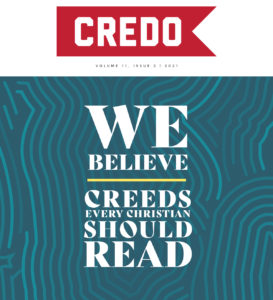
The Athanasian Creed: Ancient Wisdom on Trinitarian Grammar
T he new issue of Credo Magazine focuses on the creeds of the Christian Faith. The following is an excerpt from one of the issue’s featured articles by Justin Holcomb. Dr. Holcomb is an Episcopal priest (serving as the Canon for Vocations in the Diocese of Central Florida) and he teaches theology at Gordon-Conwell-Theological Seminary and Reformed Theological Seminary.
he new issue of Credo Magazine focuses on the creeds of the Christian Faith. The following is an excerpt from one of the issue’s featured articles by Justin Holcomb. Dr. Holcomb is an Episcopal priest (serving as the Canon for Vocations in the Diocese of Central Florida) and he teaches theology at Gordon-Conwell-Theological Seminary and Reformed Theological Seminary.
It is sometimes said that you cannot describe the Trinity without committing some sort of heresy. Either you make God out to be three gods, or you make the three persons (Father, Son, and Holy Spirit) into a sham and pretense. The reason for this is that to speak about God, to speak about the Trinity, is different from speaking about any other thing. God is categorically separate from all other subjects. God is God. And nothing else is. So when we discuss the Trinity, we are peering into what theologians call the “aseity” of God — God as he is a se, to himself. God presents himself fully only to himself. We know about the Trinity only because God lovingly reveals aspects of his being and character to us. But God knows himself very well!
Given these challenges in expressing the great mystery of the Godhead who is “one God in Trinity and Trinity in unity,” the Athanasian Creed is about as careful and thorough an attempt as can be found in the history of the church. It not only describes and summarizes the core doctrine of the Trinity but also sets boundaries to prevent potential heresies and misunderstandings from creeping in.
The Content of the Athanasian Creed
The Athanasian Creed consists of forty-two articles, which can be divided into three parts. The first part addresses the Trinity, relying heavily on Augustine’s ideas and even quoting some passages of Augustine’s On the Trinity verbatim (a strong indication that it was not written by Athanasius himself, since Athanasius died when Augustine was a young man, before he converted to Christianity).
The second part defends the two natures of Jesus that Chalcedon had explained, summarizing the results of fourth- and fifth-century debates and presenting them in a neatly distilled and lyrical Latin form.The authors of the creed take pains to identify each quality with each person to show their equality, but it is made very explicit that there is only one God. Click To Tweet
The third part of the creed consists of a set of condemnations that assert that any who will be saved must adhere to the teachings of the creed. These statements have left a bad taste in the mouths of some who don’t like to see opponents damned, but it must be recalled that all early creeds and confessions contained “anathemas,” lists of beliefs rendered unacceptable to Christian conviction by the truths expressed in the very same creeds.
The creed is designed to be practical. It begins by recognizing what Christians must believe and whom we must worship. It is essentially a guide to worship, and worship for the purpose of individual right-relatedness to God. This means worshiping one God who is revealed to be Father, Son, and Holy Spirit for “their glory is equal, their majesty coeternal.”
The Athanasian Creed then guides the worshiper through key aspects of divinity, qualities or attributes of God, that are shared by all three persons of the Trinity. God is uncreated. God is unlimited. God is eternal. Each person of the Trinity is each of these things, but does that mean that there are three separate divinities? The Father is uncreated. The Son is uncreated. The Spirit is uncreated. Since the creed makes a point of distinguishing each person from each other and since all three are uncreated, doesn’t that mean three Gods?
The creed answers with the simple formula, which it will repeat throughout, “not three, but one.” “In the same way, the Father is almighty, the Son almighty, the Holy Spirit almighty; yet there are not three almighties, but one almighty.” The authors of the creed take pains to identify each quality with each person to show their equality, but it is made very explicit that there is only one God. In this way there is no room for tritheism, the suggestion that there are three gods worshiped in Christianity. (This was never a serious suggestion in Christian circles anyway. It was used as a polemic against rival Christian groups.)
More important, the creed eliminates a prominent view of the Trinity that was very active, and openly supported throughout the fourth century. This view (sometimes called Neo-Arianism after the original advocate, Arius) was promoted by royalty and bishops alike, and suggested that while the Father, Son, and Holy Spirit were all “God,” the Son and then the Holy Spirit certainly had to be regarded as less God than God the Father. Maybe they are God, enough for us to worship them. But not as much God as the one true God at the top of the triangle. The Athanasian Creed disallows this view of God. There cannot be multiple Almighties.There cannot be multiple Almighties. Click To Tweet
Why not just think of God as a single person, if monotheism is the goal? Are the persons of the Trinity simply ways that God chooses to appear to us at various times and for various purposes? There is no room for this misunderstanding, which is sometimes referred to as Modalism because it suggests that God appears to us in different modes; or Sabellianism, after its early advocate Sabellius (exiled in AD 220). Maybe God just appears to us sometimes as Father, sometimes as Son, sometimes as Spirit. The view was untenable because Scripture records and reveals to us interactions between the persons. The Father blesses the Son. The Son prays to the Father. The Son breathes the Spirit. The Father raises the Son from the dead. We do not understand fully how the Father, Son, and Spirit interact, but as the creed teaches, we can say that the Son is “begotten” of the Father. We can say as well that the Spirit “proceeds.” (Both of these expressions come from Scripture: Ps. 2:7 and John 15:26 respectively.) The orthodox reading is more difficult to understand than simple monotheism or separating the three persons altogether, but it is most faithful to Scripture.
*Read the remainder of Justin Holcomb’s article in the latest issue of Credo Magazine.
